Building Code of New York City - Local Law 26 of 2004
Updates and ammends Title 27: Administratrive Code.
Exit Signs and Other Markings
§15. Section 27-383 of the administrative code of the city of New York is amended to read as follows: §27-383 Requirements. (a) Exit signs. Except in occupancy groups J-2 and J-3, the location of every exit on every floor and every opening from a room classified in occupancy group J-1 and containing cubicles shall be clearly indicated by exit signs. Such signs shall be placed at an angle with the exit opening if such placement is required for the signs to serve their purpose. In long corridors, in open floor areas, and in all other situations where the location of the exit may not be readily visible or understood, directional signs shall be provided to serve as guides from all portions of the corridor or floor. (b) Exit path markings in high rise office buildings and in occupancy group E high rise buildings. On and after July 1, 2006 all high rise office buildings and all high rise buildings classified in occupancy group E shall have exit path markings conforming to this subdivision. This provision shall be retroactive and shall apply to buildings constructed on and after such date and to buildings in existence on such date. All exit path markings required herein shall be of an approved photoluminescent material. The markings shall be washable, non-toxic, non radioactive, and if subjected to fire must be self extinguishing when the flame is removed. (1) All doors opening to corridors, to an exit, or to an exit passageway, shall be marked with the word “exit”. (2) Within exit stairs, horizontal extensions in exit stairs, horizontal exits, supplemental vertical exits and exit passageways, except within street level lobbies, there shall be directional markings. (3) Required markings for exit paths shall comply with the technical standards for installation and placement to be set forth in a reference standard. Such reference standard shall be designated RS 6-1 and shall be adopted on or before January 1, 2006.
§16. Article 7 of subchapter 6 of chapter one of title 27 of the administrative code of the city of New York is amended by adding a new section 27-383.1 to read as follows: §27-383.1 Additional requirements for high rise office buildings and occupancy group E high rise buildings. In high rise office buildings and in occupancy group E high rise buildings: (a) Illuminated exit signs complying with section 27-386 of this subchapter shall be placed in stairwells with horizontal extensions to indicate the transition from vertical to horizontal direction and at turns along the horizontal path. (b) A supplementary sign complying with sections 27-394 and 27-395 of this subchapter, except that the lettering and numerals shall be at least one inch high, indicating the location of a recessed re-entry door, shall be securely attached on the wall of the landing that faces the evacuee on the stairs. (c) In stairs where there is no entry or exiting from such stair for more than four floors, a sign complying with sections 27-394 and 27-395, except that the lettering and numerals shall be at least one inch high, shall be securely attached at the beginning of the descent into such portion of the stair on the wall of the landing that faces the evacuee on the stairs stating the location of the next re-entry or exiting floor. On each floor within such portion of the stair a sign complying with sections 27-392 and 27-395 shall be securely attached to the wall of the landing that faces the evacuee on the stairs approximately five feet above the floor indicating the floor number. (d) Signs shall be readily visible from the egress direction. (e) High rise office buildings and high rise buildings classified in occupancy group E in existence on the effective date of this section shall comply with this section on or before July 1, 2007. For the purpose of this section, a high rise building shall be deemed to be in existence on the effective date of this section if on such effective date it is complete or under construction or where an application for approval of plans was filed with the department prior to such effective date and construction commenced within two years after such effective date.
Download New York City Building Code Local Law 26 of 2004.
Building Code of New York City - Title 27 Administrative Code
Provides minimum requirements and standards for the regulation of building construction in the city of New York. Applies to the construction, alteration, repair, demolition, removal, maintenance, occupancy and use of new and existing buildings in the city of New York, including the installation, alteration, repair, maintenance and use of service equipment therein.
ARTICLE 6 EXIT LIGHTING
§[C26-605.1] 27-381 Requirements. - Corridors and exits shall be provided with artificial lighting facilities, except as otherwise permitted by the provisions of subchapter twelve of this chapter, in accordance with the following: (a) Illumination of at least two foot candles measured at the floor level shall be maintained continuously, during occupancy, in exits and their access facilities for their full length, at changes in direction in and intersections of corridors, balconies, exit passageways, stairs, ramps, escalators, bridges, tunnels, landings, and platforms, and as provided in subchapter eight of this chapter for places of assembly, except that this requirement shall not apply to dwelling units. (b) In buildings classified in occupancy groups B-1 and B-2, exit lighting need only be maintained when a section of floor is occupied. (c) Illumination shall be so arranged that the failure of any one light shall not leave any area in darkness. (d) Phosphorescent materials shall not be used as a method of providing illumination, nor shall battery operated electric lights or portable lamps or lanterns be used as primary sources of lighting. *(e) (1) Buildings and existing buildings containing an F-4 place of assembly with an occupant load of three hundred or more persons shall install emergency lighting in each vertical exit serving the floor on which the place of assembly is located so as to provide a continuously lighted passage to the exterior of the building. Such lighting shall be connected to an emergency power source or to storage battery equipment meeting the requirements of the commissioner. (2) Existing buildings required to comply with this subdivision shall install the emergency lighting on or before April first, nineteen hundred eighty-seven. *Local Law 59-1996.
§[C26-605.2] 27-382 Power source. - *(a) Where a total of more than four lights is required, exit lighting shall be connected to an emergency power source or to storage battery equipment meeting the requirements of the commissioner, provided, however, that in existing buildings, the exit lighting may be on circuits that are separate from the general lighting and power circuits, taken off ahead of the main switch. (b) Existing high rise buildings classified in occupancy group C, D or H and existing buildings classified in occupancy group E, G or J-1 (except for "residential hotels," as such term is defined by the commissioner pursuant to rules and regulations) shall comply with the requirements of this section on or before April first, nineteen hundred eighty-seven. *Local Law 59-1996.
***ARTICLE 7 EXIT SIGNS AND OTHER MARKINGS
***§[C26-606.1] 27-383 Requirements. - (a) Exit signs.- Except in occupancy groups J-2 and J-3, the location of every exit on every floor and every opening from a room classified in occupancy group J-1 and containing cubicles shall be clearly indicated by exit signs. Such signs shall be placed at an angle with the exit opening if such placement is required for the signs to serve their purpose. In long corridors, in open floor areas, and in all other situations where the location of the exit may not be readily visible or understood, directional signs shall be provided to serve as guides from all portions of the corridor or floor. (b) Exit path markings in high rise office buildings and in occupancy group E high rise buildings.- On and after July 1, 2006 all high rise office buildings and all high rise buildings classified in occupancy group E shall have exit path markings conforming to this subdivision. This provision shall be retroactive and shall apply to buildings constructed on and after such date and to buildings in existence on such date. All exit path markings required herein shall be of an approved photoluminescent material. The markings shall be washable, non-toxic, non radioactive, and if subjected to fire must be self extinguishing when the flame is removed. (1) All doors opening to corridors, to an exit, or to an exit passageway, shall be marked with the word “exit”. (2) Within exit stairs, horizontal extensions in exit stairs, horizontal exits, supplemental vertical exits and exit passageways, except within street level lobbies, there shall be directional markings. (3) Required markings for exit paths shall comply with the technical standards for installation and placement to be set forth in a reference standard. Such reference standard shall be designated RS 6-1 and shall be adopted on or before January 1, 2006. ***Local Law 26-2004.
**§27-383.1 Additional requirements for high rise office buildings and occupancy group E high rise buildings. - In high rise office buildings and in occupancy group E high rise buildings: (a) Illuminated exit signs complying with section 27-386 of this subchapter shall be placed in stairwells with horizontal extensions to indicate the transition from vertical to horizontal direction and at turns along the horizontal path. (b) A supplementary sign complying with sections 27-394 and 27-395 of this subchapter, except that the lettering and numerals shall be at least one inch high, indicating the location of a recessed re-entry door, shall be securely attached on the wall of the landing that faces the evacuee on the stairs. (c) In stairs where there is no entry or exiting from such stair for more than four floors, a sign complying with sections 27-394 and 27-395, except that the lettering and numerals shall be at least one inch high, shall be securely attached at the beginning of the descent into such portion of the stair on the wall of the landing that faces the evacuee on the stairs stating the location of the next re-entry or exiting floor. On each floor within such portion of the stair a sign complying with sections 27-392 and 27-395 shall be securely attached to the wall of the landing that faces the evacuee on the stairs approximately five feet above the floor indicating the floor number. (d) Signs shall be readily visible from the egress direction. (e) High rise office buildings and high rise buildings classified in occupancy group E in existence on October 22, 2004 shall comply with this section on or before July 1, 2007. For the purpose of this section, a high rise building shall be deemed to be in existence on October 22, 2004 if on such date it is complete or under construction or where an application for approval of plans was filed with the department prior to such date and construction commenced within two years after such date. **Local Law 26-2004.
§[C26-606.2] 27-384 Power source. - *(a) Where a total of more than four exit and/or directional signs is required, the signs shall be connected to an emergency power source or to storage battery equipment meeting the requirements of the commissioner, provided, however, that in existing buildings, the signs may be on circuits that are separate from the general lighting and power circuits, taken off ahead of the main switch. *Local Law 59-1996. (b) Existing high rise buildings classified in occupancy group C, D or H and existing buildings classified in occupancy group E, G or J-1 (except for "residential hotels," as such term is defined by the commissioner pursuant to rules and regulations) shall comply with the requirements of this section on or before April first, nineteen hundred eighty-seven. **(c) Notwithstanding the foregoing, in the existing buildings required to comply with subdivision (b) of this section, all such existing exit and/or directional signs on circuits taken off ahead of the main switch shall be connected to an emergency power source or to storage battery equipment meeting the requirements of the commissioner on or before July 1, 2007. **Local Law 26-2004.
§[C26-606.3] 27-385 Exit sign design. - Exit signs shall read only "exit" and shall be of the externally lighted, internally lighted, or electroluminescent type, except that they may be nonilluminated in buildings not provided with artificial lighting. (a) The artificial light source on externally lighted signs shall provide a red light, either by the use of an incandescent colored bulb or other visible red light source, so as to provide at least twenty-five foot candles on the exposed face of the sign. Visibility of the sign shall not be obscured by the location of the light source. (b) For internally lighted signs, the average initial brightness of the letters shall be at least twenty-five ft. lamberts, and where an illuminated background is used, its average initial brightness shall be at least two hundred fifty ft. lamberts. The light source shall not be modified or changed nor shall lamp life multipliers be used so as to reduce these brightness levels. (c) The letters of exit signs shall be red. The background of externally lighted signs shall be white. The background of internally lighted signs shall be either stenciled metal with a light gray or white color, or translucent frosted, opal glass, slow-burning plastic, or the plastic edgeglow type with white plastic separators. The letters for internally lighted signs shall be translucent red. (d) The letters shall be block lettering at least four and one-half inches high with nine-sixteenths inch strokes, except in buildings and spaces classified in occupancy group F and J-1, where they shall be at least eight inches high with the strokes at least three-quarters of an inch wide. (e) In locations where breakage may occur, exit signs shall be of shock resistant materials, or shall otherwise be protected against breakage. (f) Except for buildings not provided with artificial lighting and buildings which maintain one or more auxiliary systems for emergency exit lighting in the event of a public utility failure, there shall be either (1) an illuminated exit sign with the background thereon made of an approved phosphorescent material or (2) a material with an opaque text and placed adjacent to or as close as possible to such illuminated sign. The phosphorescent material after exposure to normal lighting conditions shall be capable of remaining visible in total darkness for a period of at least eight hours. The signs shall be washable, non-toxic, non-radioactive and if subjected to fire must be self-extinguishing when the flame is removed.
§[C26-606.4] 27-386 Directional sign design. - Directional exit signs shall comply with all of the requirements for exit signs in section 27-385 of this article, and shall read "EXIT" with a horizontal arrow or arrows indicating the direction to the exit or exits. However, when the arrow is below the letters, the letters may be three and three-eighths inches high and nine-sixteenths inch strokes, except in buildings and spaces classified in occupancy group F where they shall be at least five inches high with nine-sixteenths inch strokes. The arrow or arrows shall be red.
§[C26-606.5] 27-387 False exits. - Any door, passageway, stair, or other means of communication that is not an exit or that is not a way to an exit, but is so located as to be mistaken for an exit, shall be identified with a sign reading "NOT AN EXIT," shall be identified by a sign indicating its use or purpose or shall be provided with a directional exit sign.
ARTICLE 8 EXIT SIGNS FOR EXISTING BUILDINGS
§[C26-607.1] 27-388 Retroactive provisions. – Except as otherwise provided, the provisions of this subchapter are not retroactive except that the provisions of this article and article nine of subchapter six of this chapter for certain existing office buildings are retroactive. Signs required by this article must be installed no later than March sixth, nineteen hundred sixty-nine. Where auxiliary systems for emergency exit lighting are to be provided, the installation must commence no later than May sixth, nineteen hundred sixty-nine.
§C26-60[7.2] 27-389 Designation of required means of egress. - (a) Except for spaces classified in occupancy J-2 and J-3, the location of each required means of egress on every floor of every structure shall be clearly indicated by exit signs. Such signs shall be placed at an angle with the exit doorway if such placement shall be required for such signs to serve their purpose adequately. These signs shall be of an approved phosphorescent material, which after exposure to normal lighting conditions shall be capable of remaining visible in total darkness for a period of at least eight hours. They shall also be washable, nontoxic, non- radioactive, and if subjected to fire must be self-extinguishing when the flame is removed. Except for illuminated signs, these signs shall have a phosphorescent background and opaque text. Where means of egress were required to be indicated by an illuminated sign, there shall be either (1) an illuminated exit sign with the lettering thereon made of the approved phosphorescent material, or (2) a supplemental exit sign made of the approved phosphorescent material with an opaque text, and placed adjacent to or as close as possible to such illuminated sign. (b) Except for spaces classified in occupancy groups J-2 and J-3, in long corridors, in open floor areas and in all other situations where the location of the means of egress may not be readily discernible or understood by the occupants, directional signs shall be provided and maintained to serve as guides from all portions of the floor or corridor. These signs shall be of an approved phosphorescent material which after exposure to normal lighting conditions shall be capable of remaining visible in total darkness for a period of at least eight hours. They shall also be washable, non-toxic, non-radioactive, and if subjected to fire must be self-extinguishing when the flame is removed. Except for illuminated signs these signs shall have a phosphorescent background and opaque text. Where a directional sign was required to be illuminated there shall be either (1) an illuminated directional sign with the lettering, indicator, symbol or other device thereon made of the aforesaid phosphorescent material, or (2) a supplemental directional sign with the same lettering, indicator, symbol or device as appears on the illuminated sign, but opaque, on a background made of the aforesaid phosphorescent material and placed adjacent to or as close as possible to such illuminated sign. (c) Except where otherwise permitted by the provisions of any law, the lettering of exit signs shall be of letters of at least eight inches high. (d) In those buildings not provided with artificial lighting, in those buildings which maintain one or more auxiliary systems for emergency exit lighting in the event of a public utility failure, and in those buildings for which the installation of one or more such auxiliary systems is commenced on or before August sixth, nineteen hundred sixty-nine, the signs need not be phosphorescent but shall otherwise conform to this section.
ARTICLE 9 STAIR AND ELEVATOR SIGNS
*§[C26-608.1] 27-390 Applicability. - This article is applicable to all buildings and existing buildings which have at least one elevator which is subject to periodic inspections pursuant to section 27-998, any existing office building occupied or arranged to be occupied for an occupant load of more than one hundred persons above or below the street level or more than a total of five hundred persons in the entire building. *Local Law 96-1985, language juxtaposed per Ch. 907-1985.
§[C26-608.2] 27-391 Signs at elevator landings. - A sign shall be posted and maintained on every floor at the elevator landing. The sign shall read "IN CASE OF FIRE, USE STAIRS UNLESS OTHERWISE INSTRUCTED." The lettering shall be at least one-half inch block letters in red with white background or as otherwise approved by the commissioner. Such lettering shall be properly spaced to provide good legibility. The sign shall also contain a diagram showing the location where it is posted and the location and letter identification of the stairs on the floor. The sign shall be at least ten inches by twelve inches, located directly above a call button and securely attached to the wall or partition. The top of such sign shall not be above six feet from the floor level. The diagram on such sign may be omitted provided that signs containing such diagram are posted in conspicuous places on the respective floor. In such case, the sign at the elevator landing shall be at least two and one half inches by ten inches and the diagram signs shall be at least eight inches by twelve inches.
§[C26-608.3] 27-392 Floor numbering signs. - A sign shall be posted and maintained within each stair enclosure on every floor, indicating the number of the floor. The numerals shall be of bold type and at least three inches high. The numerals and background shall be in contrasting colors. The sign shall be securely attached to the stair side of the door.
§[C26-608.4] 27-393 Stair and elevator identification signs. - Each stair and each bank of elevators shall be identified by an alphabetic letter. A sign indicating the letter of identification for the elevator bank shall be posted and maintained at each elevator landing directly above or as part of the sign specified in section 27-391 of this article. The stair identification sign shall be posted and maintained on the occupancy side of the stair door. The letter on the sign shall be at least three inches high, of bold type and of contrasting color from the background. Such signs shall be securely attached.
§[C26-608.5] 27-394 Stair re-entry signs in office buildings. - Signs shall be posted and maintained on the stair door at each floor in buildings classified in occupancy group E occupied or arranged to be occupied for an occupant load of more than one hundred persons above or below the street level or more than a total of five hundred persons in the entire building indicating whether reentry is provided into the building and the floor where such re-entry is provided. The lettering and numerals of the signs shall be at least one-half inch high of bold type. The lettering and background shall be contrasting colors and the signs shall be securely attached approximately five feet above the floor. The signs shall read as follows and may be either independent or combined with the corresponding sign required by sections 27-392 and 27-393 of this article. (a) Where no re-entry is provided from the stairs to any floor, the sign shall read "NO RE-ENTRY FROM THIS STAIR" and such sign shall be on the occupancy side of the stair door at each floor. No re-entry sign shall be required on the stair side of the door. (b) Where re-entry is provided to specified floors: (1) On the stair side of the door at floors where reentry is provided, the sign shall read "RE-ENTRY ON THIS FLOOR." (2) Where no re-entry is provided on that floor, the sign on the stair side of the door shall read "NO RE-ENTRY, NEAREST RE-ENTRY ON THE...... AND..... FLOORS." The floor numbers of the nearest re-entry below and the nearest re-entry floor above shall be entered in the blank spaces.
§[C26-608.6] 27-395 Materials for signs. – Signs required by this article shall be of metal or other durable material.
§[C26-608.7] 27-396 Signs in existing buildings. - (a) Signs installed prior to the enactment of this article may be accepted by the commissioner, provided that such signs will adequately accomplish the intended purpose. (b) In buildings existing prior to January eighteenth, nineteen hundred seventy-three, the commissioner may modify the requirements as to location of signs where compliance would cause practical difficulty or undue hardship. (c) All existing buildings not already subject to the requirements of this article as of January eighteenth, nineteen hundred seventy-three shall comply with the requirements of this article on or before October first, nineteen hundred eighty-five.
ARTICLE 10 SIGNS IN SLEEPING ROOMS
§[C26-609.1] 27-396.1 Applicability. - This article is applicable to buildings and existing buildings classified in occupancy group J-1.
§[C26-609.2] 27-396.2 Requirements. - All buildings and existing buildings classified in occupancy group J-1 shall post and maintain a sign on the inside of every door opening onto a public corridor giving access to a sleeping room. The sign shall contain a diagram showing the location where it is posted and the location and letter identification of the exit stairs on the floor. The diagram shall indicate the number of doors opening onto the public corridor which must be passed to reach each exit stair. The sign shall be at least eight inches by ten inches, located on the inside of the door and securely attached thereto. The top of such sign shall not be more than six feet from the floor level. Such sign shall contain such additional information as the fire department may require.
§[C26-609.3] 27-396.3 Retroactive requirements. - All existing buildings required to comply with the provisions of this article shall post the requisite signs on or before April first, nineteen hundred eighty-seven. Signs installed prior to such date may be accepted by the commissioner, provided that such signs adequately accomplish the intended purpose.
Building Code of New York City - Reference Standard 6-1
Provides minimum requirements for photoluminescent exit signs and path markings. This standard covers: 1) the technical specifications for minimum performance of the materials; 2) the minimum requirements for placement of the signs and markings; 3) administrative filings to certify compliance; and 4) maintenance requirements.
Overview
Photoluminescent exit path markings as required by Local Law 26 of 2004, New York City Building Code § 27-383(b).
Introduction
This standard is intended to provide minimum requirements for photoluminescent exit path markings that will aid in evacuation from buildings in the event of failure of both the power and back-up power to the lighting and illuminated exit signs. Photoluminescent material is charged by exposure to light and will emit luminance after the activating light source is unavailable. The markings covered by this standard are not designed to provide enough light to illuminate a dark egress path, but rather will provide luminescent signs and outlines of the egress path, stairs, handrails, and obstacles, so that occupants can discern these egress path elements in dark conditions. The markings are generally required to be located at a low location in case of smoke and to be readily seen, such as in a crowd situation. They are in addition to, and not as a substitute for, any other signage required under the Building Code, such as electrically illuminated exit signs with electrical back-up power required under § 27-383(a).
Egress Sign Detail
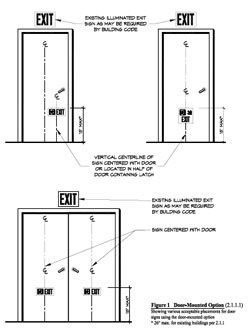 |
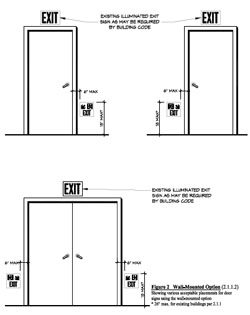 |
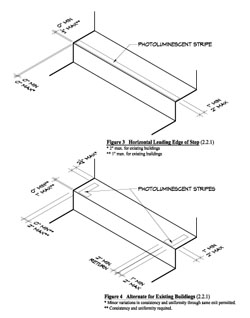 |
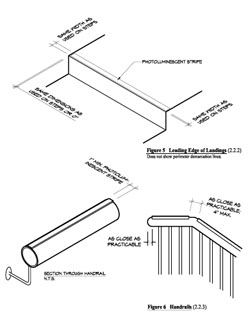 |
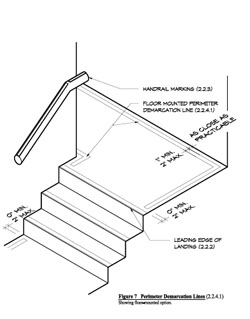 |
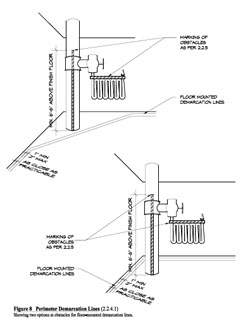 |
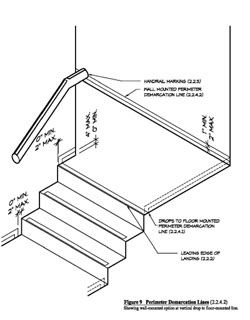 |
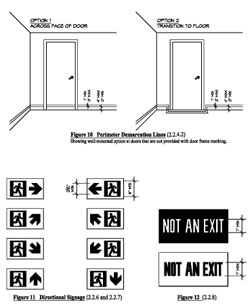 |
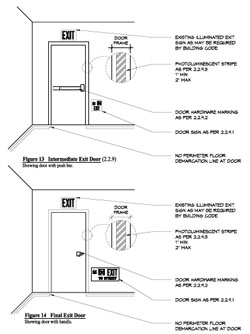 |
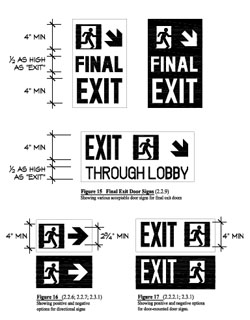 |
Download New York City Building Code Reference Standard 6-1.



